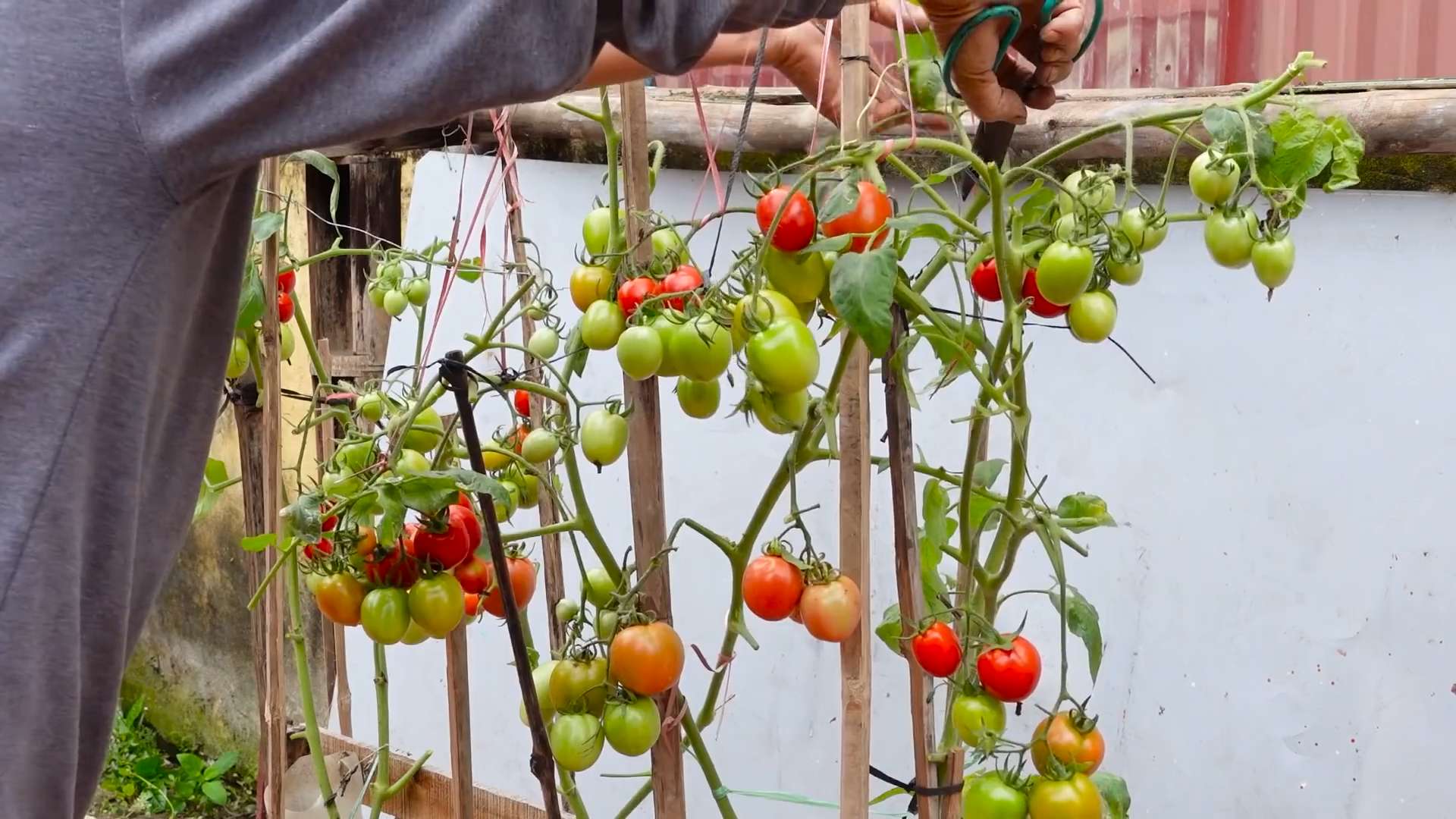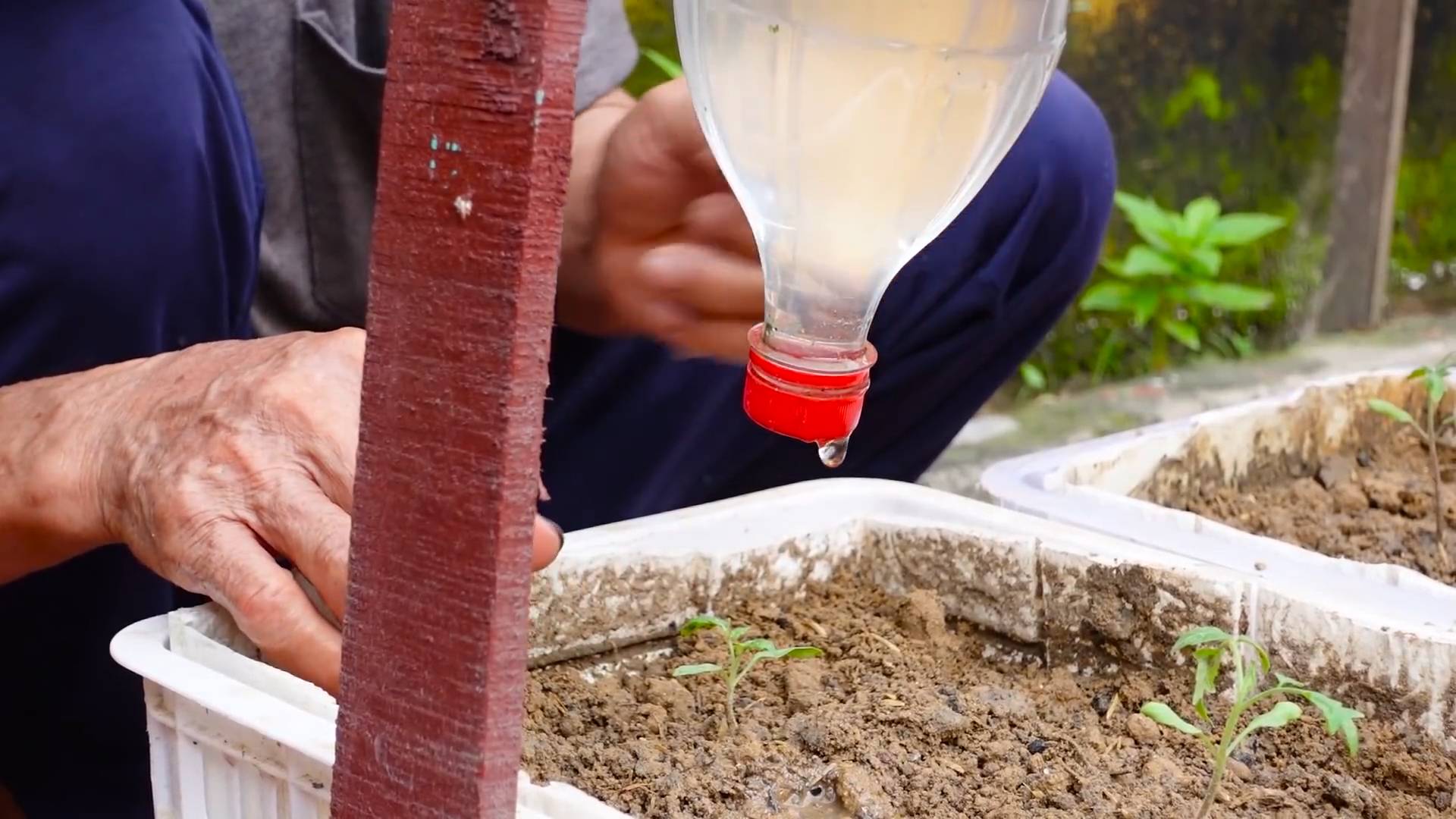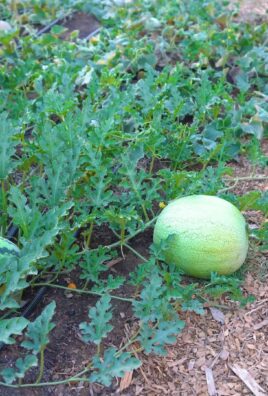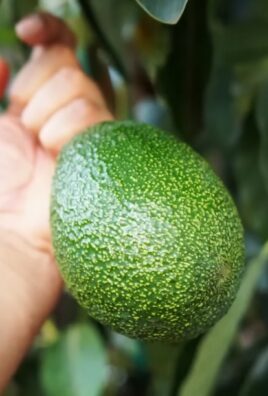Grow Tomatoes Indoors? Absolutely! Imagine plucking a sun-ripened, juicy tomato right from your own indoor garden, even in the dead of winter. Sounds like a dream, right? Well, it’s a dream that can easily become a reality with a few clever DIY tricks and a little know-how. For centuries, humans have cultivated plants indoors, from the elaborate orangeries of European royalty to the humble windowsill herb gardens of today. But growing tomatoes indoors presents a unique challenge, one that requires a bit of ingenuity and understanding of these sun-loving fruits.
Why bother with the effort? Because fresh, flavorful tomatoes shouldn’t be a seasonal luxury! Store-bought tomatoes often lack the vibrant taste and nutritional value of homegrown ones. Plus, there’s immense satisfaction in nurturing a plant from seed to fruit, especially when you’ve conquered the indoor growing challenge. In this article, I’m going to share some of my favorite DIY hacks and tips to help you successfully grow tomatoes indoors, regardless of your experience level. Get ready to transform your living space into a thriving, edible oasis!

Growing Tomatoes Indoors: A Comprehensive DIY Guide
Hey there, fellow gardening enthusiasts! Ever dreamt of biting into a juicy, sun-ripened tomato in the dead of winter? Well, dream no more! Growing tomatoes indoors is totally achievable, and I’m here to guide you through every step of the process. It might seem daunting, but trust me, with a little patience and the right setup, you’ll be enjoying homegrown tomatoes year-round.
Choosing the Right Tomato Variety
Before we dive into the nitty-gritty, let’s talk about tomato varieties. Not all tomatoes are created equal, especially when it comes to indoor growing. We need to choose varieties that are compact, early-maturing, and self-pollinating.
* Determinate vs. Indeterminate: This is crucial! Determinate varieties grow to a specific size and produce all their fruit at once, making them ideal for containers. Indeterminate varieties, on the other hand, keep growing and producing fruit throughout the season, which can be challenging indoors.
* Compact Varieties: Look for varieties labeled “dwarf,” “patio,” or “bush.” These stay relatively small and manageable in pots.
* Self-Pollinating: Tomatoes are generally self-pollinating, but some varieties benefit from a little help indoors. We’ll cover that later.
Some of my favorite indoor tomato varieties include:
* Tiny Tim: A super compact variety that produces small, cherry-sized tomatoes.
* Roma: A determinate variety that produces plum-shaped tomatoes, great for sauces.
* Patio: As the name suggests, this variety is perfect for patios and containers.
* Tumbling Tom: Ideal for hanging baskets, producing cascading vines of cherry tomatoes.
* Balkonzauber: Another great dwarf variety, perfect for smaller spaces.
Setting Up Your Indoor Tomato Garden
Okay, now that we’ve chosen our tomato varieties, let’s get our indoor garden ready. This is where the magic happens!
* Lighting: This is the most important factor for indoor tomato growing. Tomatoes need at least 6-8 hours of direct sunlight per day. If you don’t have a sunny south-facing window, you’ll need to invest in grow lights.
* Potting Mix: Don’t use garden soil! It’s too heavy and doesn’t drain well. Use a high-quality potting mix specifically designed for containers.
* Containers: Choose pots that are at least 5 gallons in size. This gives the roots enough room to grow. Make sure the pots have drainage holes!
* Support: As your tomato plants grow, they’ll need support. Use stakes, cages, or trellises to keep them upright.
* Temperature: Tomatoes thrive in temperatures between 65-85°F (18-29°C).
Step-by-Step Planting Guide
Alright, let’s get our hands dirty! Here’s how to plant your tomato seeds or seedlings:
1. Starting from Seed (Optional): If you’re starting from seed, sow them indoors 6-8 weeks before you want to transplant them. Fill a seed tray with seed starting mix, sow the seeds about ¼ inch deep, and keep them moist. Place the tray under grow lights or in a sunny window. Once the seedlings have a few sets of true leaves, you can transplant them into individual pots.
2. Choosing Seedlings: If you’re buying seedlings, choose healthy-looking plants with sturdy stems and no signs of disease.
3. Preparing the Pot: Fill your chosen container with potting mix, leaving about an inch of space at the top.
4. Planting the Seedling: Gently remove the seedling from its container. If the roots are root-bound (tightly circling the pot), gently loosen them with your fingers.
5. Planting Depth: Plant the seedling deeper than it was in its original container. Tomatoes can grow roots along their stems, so planting them deeper will encourage a stronger root system. Remove the lower leaves and bury the stem up to the first set of leaves.
6. Watering: Water the newly planted seedling thoroughly until water drains out of the drainage holes.
7. Placement: Place the pot in a sunny location or under grow lights.
Caring for Your Indoor Tomato Plants
Now that your tomato plants are planted, it’s time to give them the TLC they need to thrive.
1. Watering: Water your tomato plants regularly, keeping the soil consistently moist but not soggy. Overwatering can lead to root rot. Check the soil moisture by sticking your finger about an inch into the soil. If it feels dry, it’s time to water.
2. Fertilizing: Tomatoes are heavy feeders, so they need regular fertilization. Use a balanced fertilizer (e.g., 10-10-10) or a tomato-specific fertilizer. Follow the instructions on the fertilizer package. I like to fertilize every 2-3 weeks.
3. Pruning: Pruning helps to improve air circulation and encourage fruit production. Remove any suckers (small shoots that grow between the main stem and the branches). These suckers will steal energy from the plant and reduce fruit yield.
4. Pollination: While tomatoes are self-pollinating, they sometimes need a little help indoors. You can gently shake the plants or use a small brush to transfer pollen from one flower to another. A small fan blowing gently on the plants can also help with pollination.
5. Pest and Disease Control: Keep an eye out for pests like aphids, whiteflies, and spider mites. Treat infestations with insecticidal soap or neem oil. Prevent fungal diseases by providing good air circulation and avoiding overwatering.
6. Supporting the Plant: As the plant grows, make sure to provide adequate support with stakes, cages, or trellises. This will prevent the plant from collapsing under the weight of the fruit.
Harvesting Your Tomatoes
The moment we’ve all been waiting for! Harvesting your homegrown tomatoes is the most rewarding part of the process.
1. Ripeness: Tomatoes are ripe when they are fully colored and slightly soft to the touch.
2. Harvesting Technique: Gently twist the tomato off the vine.
3. Enjoy! Savor the taste of your homegrown tomatoes! Use them in salads, sauces, sandwiches, or just eat them straight off the vine.
Troubleshooting Common Problems
Even with the best care, you might encounter some problems along the way. Here are some common issues and how to fix them:
* Yellowing Leaves: This can be caused by overwatering, underwatering, nutrient deficiencies, or pests. Check the soil moisture, fertilize if necessary, and inspect for pests.
* Blossom End Rot: This is caused by a calcium deficiency. Ensure consistent watering and add calcium to the soil.
* Lack of Fruit: This can be caused by poor pollination, insufficient light, or extreme temperatures. Ensure adequate light, assist with pollination, and maintain a consistent temperature.
* Pests: Regularly inspect your plants for pests and treat them promptly with appropriate methods.
Extra Tips for Success
Here are a few extra tips to help you succeed with your indoor tomato garden:
* Rotate your plants: If you’re using grow lights, rotate your plants regularly to ensure even light exposure.
* Clean your equipment: Regularly clean your pots, tools, and grow lights to prevent the spread of diseases.
* Don’t give up! Growing tomatoes indoors can be challenging, but it’s also incredibly rewarding. Don’t be discouraged if you encounter problems along the way. Just keep learning and experimenting, and you’ll eventually find what works best for you.
* Consider Hydroponics: If you’re feeling adventurous, you can try growing tomatoes hydroponically. This method involves growing plants in water without soil, and it can be very efficient for indoor gardening. There are many hydroponic systems available, from simple DIY setups to more sophisticated commercial systems.
* Air Circulation is Key: Good air circulation is crucial for preventing fungal diseases. A small fan can make a big difference.
* Record Keeping: Keep a journal of your tomato growing journey. Note the varieties you planted, the dates you planted them, the fertilizers you used, and any problems you encountered. This will help you learn from your mistakes and improve your results in the future.
Growing tomatoes indoors is a fun and rewarding experience. With a little effort and the right knowledge, you can enjoy fresh, homegrown tomatoes all year round. Happy gardening!

Conclusion
So, there you have it! Growing tomatoes indoors might seem like a daunting task, but with a little patience, the right setup, and these simple DIY tricks, you can enjoy the taste of homegrown, sun-ripened (or, well, lamp-ripened!) tomatoes all year round. Forget those bland, store-bought varieties that lack that vibrant, juicy flavor. Imagine biting into a sweet, tangy tomato, knowing you nurtured it from seed to fruit, right in the comfort of your own home.
This isn’t just about having fresh tomatoes; it’s about the satisfaction of creating something yourself, connecting with nature, and adding a touch of green to your living space. Plus, think of the bragging rights! “Oh, these tomatoes? I grew them myself, indoors, in January.”
But the best part? You can customize this process to fit your own needs and preferences. Experiment with different tomato varieties – cherry tomatoes are particularly well-suited for indoor growing due to their smaller size and faster maturation. Try different types of grow lights to see which yields the best results for you. Consider adding companion plants like basil or marigolds to your indoor garden to deter pests and enhance the flavor of your tomatoes. You can even explore hydroponic systems for a soil-free growing experience.
Don’t be afraid to get creative and adapt these techniques to your specific environment and resources. Maybe you’ll discover a new and improved method for indoor tomato cultivation! The possibilities are endless.
Growing tomatoes indoors is a rewarding experience that offers a delicious and sustainable way to enjoy fresh produce year-round. It’s a fantastic project for beginners and experienced gardeners alike.
Now, it’s your turn! We encourage you to give this DIY trick a try. Start small, learn as you go, and don’t be discouraged by initial setbacks. Gardening is a journey, and even the most seasoned gardeners face challenges along the way.
Most importantly, share your experience with us! We’d love to hear about your successes, your failures, and any tips or tricks you discover along the way. Post photos of your indoor tomato garden, share your favorite recipes using your homegrown tomatoes, and let us know what worked best for you. Together, we can create a community of indoor tomato growers and learn from each other’s experiences.
So, grab your seeds, your soil, and your grow lights, and get ready to embark on a delicious and rewarding adventure. Happy growing!
Frequently Asked Questions (FAQ)
What are the best tomato varieties to grow indoors?
While you can technically grow any tomato variety indoors, some are better suited than others. Determinate varieties, which grow to a specific size and produce all their fruit at once, are generally easier to manage indoors than indeterminate varieties, which continue to grow and produce fruit throughout the season. Cherry tomatoes, grape tomatoes, and other smaller varieties are also a good choice because they tend to mature faster and require less space. Some popular indoor tomato varieties include:
* Tiny Tim
* Roma
* Patio
* Tumbling Tom
* Balcony
Consider the size of your growing space and the amount of light you can provide when choosing a variety. Read seed descriptions carefully to understand the plant’s growth habit and requirements.
How much light do indoor tomatoes need?
Tomatoes need a lot of light to thrive, typically 6-8 hours of direct sunlight per day. If you don’t have a sunny window that provides enough light, you’ll need to supplement with grow lights. LED grow lights are a popular choice because they are energy-efficient and provide the full spectrum of light that plants need. Fluorescent grow lights are another option, but they may not be as effective as LEDs.
When using grow lights, position them close enough to the plants to provide adequate light intensity, but not so close that they burn the leaves. A good rule of thumb is to keep the lights about 6-12 inches away from the top of the plants. You can also use a light meter to measure the light intensity and adjust the position of the lights accordingly.
What kind of soil should I use for indoor tomatoes?
Use a well-draining potting mix specifically formulated for vegetables. Avoid using garden soil, as it can be too heavy and may contain pests or diseases. A good potting mix will provide adequate drainage, aeration, and nutrients for your tomato plants. You can also amend the potting mix with compost or other organic matter to improve its fertility.
Consider using a soilless mix, such as coco coir or perlite, if you’re growing tomatoes hydroponically. These mixes provide excellent drainage and aeration, and they are less likely to harbor pests or diseases.
How often should I water my indoor tomato plants?
Water your tomato plants when the top inch of soil feels dry to the touch. Avoid overwatering, as this can lead to root rot. When you water, water deeply, until the water drains out of the bottom of the pot. This will ensure that the roots are thoroughly moistened.
The frequency of watering will depend on several factors, including the size of the pot, the type of soil, the temperature, and the humidity. Check the soil moisture regularly and adjust your watering schedule accordingly.
How do I pollinate my indoor tomato plants?
Tomatoes are self-pollinating, but they may need a little help to pollinate indoors, especially if there is no wind or insect activity. You can hand-pollinate your tomato plants by gently shaking the flowers or using a small brush to transfer pollen from one flower to another. You can also use a fan to create a gentle breeze that will help to distribute the pollen.
Another option is to use a vibrating toothbrush to vibrate the flower stems. This will help to release the pollen and improve pollination rates.
How do I fertilize my indoor tomato plants?
Tomatoes are heavy feeders and need regular fertilization to produce abundant fruit. Use a balanced fertilizer specifically formulated for tomatoes, following the instructions on the label. Start fertilizing your plants when they begin to flower and continue fertilizing them throughout the growing season.
You can also use organic fertilizers, such as compost tea or fish emulsion. These fertilizers provide a slow-release source of nutrients and can help to improve the soil health.
What are some common pests and diseases that affect indoor tomatoes?
Indoor tomatoes are susceptible to the same pests and diseases as outdoor tomatoes, including aphids, whiteflies, spider mites, and fungal diseases. Inspect your plants regularly for signs of pests or diseases and take action promptly to prevent them from spreading.
You can control pests by hand-picking them off the plants, spraying them with insecticidal soap, or introducing beneficial insects, such as ladybugs. You can prevent fungal diseases by providing good air circulation, avoiding overwatering, and using a fungicide if necessary.
How long does it take to grow tomatoes indoors?
The time it takes to grow tomatoes indoors will depend on the variety, the growing conditions, and your level of experience. Generally, it takes about 60-80 days from transplanting to harvest. Cherry tomatoes tend to mature faster than larger varieties.
Be patient and don’t be discouraged if your plants don’t produce fruit right away. With proper care and attention, you’ll be enjoying homegrown tomatoes in no time.
Can I grow tomatoes indoors year-round?
Yes, you can grow tomatoes indoors year-round, provided you have the right setup and growing conditions. You’ll need to provide adequate light, temperature, and humidity, and you’ll need to pollinate your plants manually.
Growing tomatoes indoors in the winter can be a great way to enjoy fresh produce when it’s not available outdoors. It can also be a fun and rewarding hobby.
What if my tomato plants are not producing fruit?
There are several reasons why your tomato plants may not be producing fruit. Some common causes include:
* Lack of pollination
* Insufficient light
* Extreme temperatures
* Nutrient deficiencies
* Pest or disease problems
Check your growing conditions and make sure that your plants are getting enough light, water, and nutrients. Hand-pollinate your plants if necessary. Inspect your plants for signs of pests or diseases and take action to control them. With a little troubleshooting, you should be able to get your tomato plants producing fruit in no time.





Leave a Comment